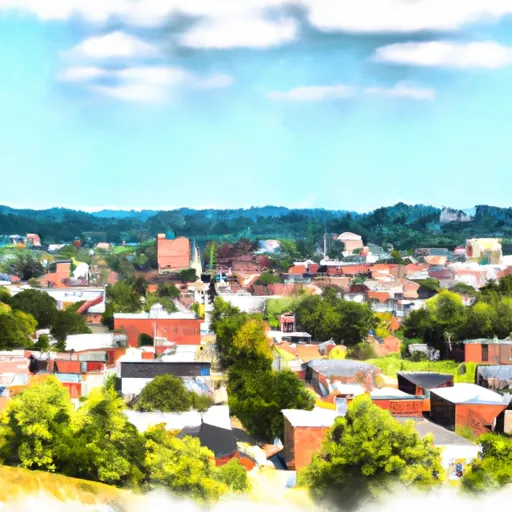-
 Snoflo Premium
Snoflo Premium
Get unlimited access to all our content
With no Ad interruptions! - Start Your Free Trial Login with existing account
Sparta
Eden Index
Climate
8.2
•
Recreation
3.4
•
Community
•
Safeguard
4.5/10

Sparta, Kentucky is a small town located in Gallatin County. It experiences a humid subtropical climate, characterized by hot and humid summers and mild winters. The average temperature in summer ranges from the mid-80s to low 90s Fahrenheit, while winter temperatures typically range from the mid-20s to mid-40s Fahrenheit. Precipitation is relatively evenly distributed throughout the year, with rainfall being the most common form of precipitation.
Sparta is situated near the Ohio River, which provides access to hydrology constituents such as fishing and boating opportunities. The river is known for its diverse fish species, including bass, crappie, and catfish, attracting anglers from near and far.
Outdoor enthusiasts in Sparta have a variety of recreational opportunities to enjoy. Nearby General Butler State Resort Park offers hiking trails, horseback riding, camping, and golfing. The park also has a lake where visitors can go fishing or rent paddleboats. Additionally, Sparta is close to several nature reserves and wildlife management areas, providing opportunities for birdwatching, hunting, and wildlife observation.
Overall, Sparta, Kentucky offers a pleasant climate, access to water-related activities, and diverse outdoor recreation opportunities for nature lovers and outdoor enthusiasts alike.
What is the Eden Index?
The Snoflo Eden Index serves as a comprehensive rating system for regions, evaluating their desirability through a holistic assessment of climate health, outdoor recreation opportunities, and natural disaster risk, acknowledging the profound impact of these factors on livability and well-being.
Climate Health Indicator (CHI): 8.2
Sparta receives approximately
1160mm of rain per year,
with humidity levels near 81%
and air temperatures averaging around
13°C.
Sparta has a plant hardyness factor of
6, meaning
plants and agriculture in this region thrive during a short period during spring and early summer. Most
plants will die off during the colder winter months.
By considering the ideal temperature range, reliable water supplies, clean air, and stable seasonal rain or snowpacks, the Climate Health Indicator (CHI) underscores the significance of a healthy climate as the foundation for quality living.
A healthy climate is paramount for ensuring a high quality of life and livability in a region, fostering both physical well-being and environmental harmony. This can be characterized by ideal temperatures, reliable access to water supplies, clean air, and consistent seasonal rain or snowpacks.
Weather Forecast
Streamflow Conditions
Kentucky
Area Rivers
Kentucky
Snowpack Depths
Kentucky
Reservoir Storage Capacity
Kentucky
Groundwater Levels
Recreational Opportunity Index (ROI): 3.4
The Recreational Opportunity Index (ROI) recognizes the value of outdoor recreational options, such as parks, hiking trails, camping sites, and fishing spots, while acknowledging that climate plays a pivotal role in ensuring the comfort and consistency of these experiences.
Access to outdoor recreational opportunities, encompassing activities such as parks, hiking, camping, and fishing, is crucial for overall well-being, and the climate plays a pivotal role in enabling and enhancing these experiences, ensuring that individuals can engage in nature-based activities comfortably and consistently.
Camping Areas
| Campground | Campsites | Reservations | Toilets | Showers | Elevation |
|---|---|---|---|---|---|
| Boat Ramp - Elmer Davis Lake - DFWR | None | 735 ft | |||
| Bandy Creek - Big South Fork Area | 147 | 1,562 ft | |||
| Great Meadows | 18 | 1,038 ft | |||
| Miami Whitewater Forest | 50 | 543 ft | |||
| Paul Ogle Riverfront Park | None | 451 ft | |||
| Lake Cumberland State Park | 150 | 911 ft | |||
| Big Bone Lick State Park | 60 | 496 ft | |||
| Fishing Creek - Lake Cumberland | 45 | 805 ft | |||
| Pickett State Rustic Park | 32 | 1,586 ft | |||
| Cumberland Point - Lake Cumberland | 30 | 906 ft |
Nearby Ski Areas
Catastrophe Safeguard Index (CSI):
The Catastrophe Safeguard Index (CSI) recognizes that natural disaster risk, encompassing floods, fires, hurricanes, and tornadoes, can drastically affect safety and the overall appeal of an area.
The level of natural disaster risk in a region significantly affects safety and the overall livability, with climate change amplifying these risks by potentially increasing the frequency and intensity of events like floods, fires, hurricanes, and tornadoes, thereby posing substantial challenges to community resilience and well-being.
Community Resilience Indicator (CRI):
The Community Resilience Indicator (CRI) recognizes that education, healthcare, and socioeconomics are crucial to the well-being of a region. The CRI acknowledges the profound impact of these elements on residents' overall quality of life. By evaluating educational resources, healthcare accessibility, and economic inclusivity, the index captures the essential aspects that contribute to a thriving community, fostering resident satisfaction, equity, and social cohesion.

